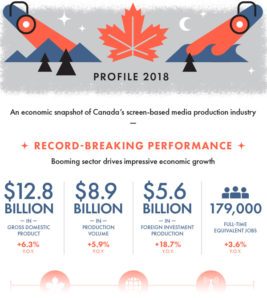While 2018 was a record year for overall film and television production volume in Canada, reaching a high of $8.9 billion ($12.8 billion in GDP) and generating 179,000 jobs, the Canadian Media Producers Association (CMPA) says its latest report contains some concerning trends where Canadian content production is concerned.
Profile 2018, published by the CMPA in collaboration with the Department of Canadian Heritage, Telefilm Canada, the Association québécoise de la production médiatique (AQPM) and Nordicity, provides an analysis of economic activity in Canada’s screen-based production industry from Apr. 1, 2017 to Mar. 31, 2018. It also provides comprehensive reviews of the historical trends in production activity between fiscal years 2008/09 and 2017/18.
The total volume of film and television production in Canada increased by 5.9 per cent to an all-time high of $8.92 billion in 2017/18. Virtually all of the growth was driven by another sharp increase in the volume of Foreign Location Shooting (FLS). It rose by $993 million to an all-time high of $4.77 billion in 2017/18, after increasing by $1.12 billion in 2016/17. The volume of Canadian theatrical feature film production also rose by $17 million, or 13.9 per cent, in 2017/18. Those increases were partially offset, however, by a $309 million decrease in the volume of Canadian television production and a $201 million decrease in the volume of broadcaster in-house production.
 “These impressive numbers illustrate that our incredibly skilled workforce, underpinned by strong production infrastructure, have built Canada’s industry into one of the world’s foremost production sectors,” said Reynolds Mastin, President and CEO, CMPA. “However, the numbers show there are clouds forming on the horizon, which require attention if we are to strive for a balanced sector, where Canadian and international productions reinforce one another, and where there is opportunity for Canadian stories to thrive in the digital era.”
“These impressive numbers illustrate that our incredibly skilled workforce, underpinned by strong production infrastructure, have built Canada’s industry into one of the world’s foremost production sectors,” said Reynolds Mastin, President and CEO, CMPA. “However, the numbers show there are clouds forming on the horizon, which require attention if we are to strive for a balanced sector, where Canadian and international productions reinforce one another, and where there is opportunity for Canadian stories to thrive in the digital era.”
Canadian film and TV projects dropped by 8.8 per cent from the all-time peak of $3.3 billion in 2016-17, to $3.04 billion. Furthermore, production of broadcaster in-house projects dropped to a volume of $1.12 billion, a year-over-year decrease of 15 per cent.
Looking at Canadian television only, production decreased 10.2 per cent to $2.73 billion, with the production of Canadian series decreasing in both number (827 to 802) and volume
($2.63 to $2.35 billion). Canadian TV production from Ontario-based producers decreased by 9.2 per cent to $1.23 billion; from Quebec-based producers by 17.7 per cent to $765 million; and by BC-based producers by 15.1 per cent to $438 million.
The decrease is due in part to a decline in the commission and financing of Canadian TV productions through private broadcaster licence fees. Year-over-year, these fees dropped by 17 per cent, from $434 million to $360 million, with cord-cutting and cord-shaving fueling a gradual decline in the size of and revenue from the Canadian BDU industry.
“It’s no secret that ‘cord-cutting’ and shifts in audience viewing habits are upending the system,” said Mastin. “Taken together, these numbers reinforce our support of the federal government’s current Broadcasting and Telecommunications Legislative Review, and with the hope that all players who benefit from our industry also invest in its continued success.”
Foreign Location Shooting by province

Foreign Location Shooting (FLS) in Canada increased by 26.3 per cent to an all-time high of $4.77 billion. The number of FLS productions was up 18.5 per cent – from 400 to 474.
204 FLS television series were shot in Canada, up from 137. The total volume of FLS television series production increased by 65 per cent, from $1.72 billion to $2.84 billion.
The five provinces hosting the largest volumes of FLS production in 2016/17 all experienced an increase in production volume in 2017/18:
• FLS production in British Columbia increased by 31.5 per cent to $3.04 billion.
• FLS production in Ontario increased by 3.2 per cent to $910 million.
• FLS production in Quebec increased by 64.9 per cent to $666 million.
Only Nova Scotia and the Territories saw their annual volume of FLS production drop in 2017/18. Canada’s leading province for FLS production, BC, accounted for nearly three quarters of the Canada-wide growth. According to Creative BC, the province’s reputation as a global production hub and its human and physical infrastructure have allowed it to continue benefiting from the global expansion in television production, driven in part by increased spending by subscription SVOD platforms like Netflix, Amazon and Hulu. BC’s growth has also been underpinned by the production sector’s increasing use of VFX and Vancouver’s reputation as a hub, alongside London, San Francisco, New York and Montreal.
Quebec was another beneficiary of the rising global demand for television production in Canada. FLS television series in that province rose from 10 to 26, with total production spending increasing five-fold from $33 million to $197 million. Big-budget series
commissioned by SVOD platforms, such as Amazon’s Tom Clancy’s Jack Ryan, underpinned the growth in Quebec.
FLS production in Ontario grew at a more modest rate in 2017/18, increasing by 3.2 per cent to a record of $910 million. Ontario was home to several returning FLS series, including Suits, 12 Monkeys and The Handmaid’s Tale, as well as new series Star Trek: Discovery and Titans.
In Manitoba, the arrival of the province’s first Netflix feature film, How It Ends, helped lift FLS production by 27.1 per cent to a 10-year high of $89 million. In Alberta, the volume of FLS production rose by $1 million to $55 million.
Subscribe Now – Free!
Broadcast Dialogue has been required reading in the Canadian broadcast media for 25 years. When you subscribe, you join a community of connected professionals from media and broadcast related sectors from across the country.
The Weekly Briefing from Broadcast Dialogue is delivered exclusively to subscribers by email every Thursday. It’s your link to critical industry news, timely people moves, and excellent career advancement opportunities.
Let’s get started right now.




